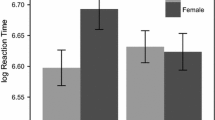Abstract
A test of gender discrimination in response to familiar labels was developed and given to 17- to 42-month-old children. A pretest employing pictures of familiar objects was presented first to ensure that subjects could perform a discrimination task, followed by separate gender tests comprised of photographs of stereotypically masculine and feminine children and adults. There were no sex differences in performance for the gender tests, but among the youngest children, more boys than girls could not be tested. Psychometric aspects of the tests were investigated and found adequate. The tests allow individual children to be classified as to gender-labeling ability and provide a useful tool for investigating gender knowledge.
Similar content being viewed by others
References
Blakemore, J. E. O., LaRue, A. A., & Olejnik, A. B. Sex-appropriate toy preference and the ability to conceptualize toys as sex-role related. Developmental Psychology, 1979, 15, 339–340.
Brooks-Gunn, J., & Lewis, M. Why Mama and Papa: The development of social labels. Child Development, 1979, 50, 1203–1206.
Constantinople, A. Sex-role acquisition: In search of the elephant. Sex Roles, 1979, 2, 121–133.
Eaton, W. O., & Von Bargen, D. Asynchronous development of gender understanding in children. Child Development, 1981, 52, 1020–1027.
Emmerich, W., Goldman, K. S., Kirsh, B., & Sharabany, R. Evidence for a transitional phase in the development of gender constancy. Child Development, 1977, 48, 930–936.
Fagot, B. I. Sex differences in toddlers' behavior and parental reaction. Developmental Psychology, 1974, 10, 459–465.
Fagot, B. I. The influence of sex of child on parental reactions to toddler children. Child Development, 1978, 49, 459–465.
Fagot, B. I., Leinbach, M. D., & Hagan, R. Gender labeling and the adoption of sex-typed behaviors. Developmental Psychology, 1986, 22, 440–443.
Fein, G., Johnson, D., Kosson, N., Stork, L., & Wasserman, L. Sex stereotypes and preferences in the toy choices of 20-month-old boys and girls. Developmental Psychology, 1975, 4, 527–528.
Gelman, S. A., & Markman, E. M. Natural kind terms and children's ability to draw inferences. Paper presented at the annual meeting of the Western Psychological Association, San Francisco, Calif., April 1983.
Gelman, S. A., Collman, P., & Maccoby, E. E. Inferring properties from categories versus inferring categories from properties: The case of gender. Child Development, 1986, 57, 396–404.
Gettys, L. D., & Cann, A. Children's perceptions of occupational sex stereotypes. Sex Roles, 1981, 7, 301–308.
Gouze, K. R., & Nadelman, L. Constancy of gender identity for self and others in children between the ages of three and seven. Child Development, 1980, 51, 275–278.
Huston, A. D. Sex-typing. In P. H. Mussen (Ed.), Handbook of child psychology: Vol. 4. Socialization, personality, and social development. New York: Wiley, 1983.
Kohlberg, L. A. A cognitive-developmental analysis of children's sex-role concepts and attitudes. In E. E. Maccoby (Ed.), The development of sex differences. Stanford, Calif.: Stanford University Press, 1966.
Kuhn, D., Nash, S. C., & Brucken, L. Sex role concepts of two- and three-year-olds. Child Development, 1978, 49, 445–451.
Lewis, M., & Weinraub, M. Origins of early sex-role development. Sex Roles, 1979, 5, 135–153.
Maccoby, E. E. Social development. New York: Harcourt Brace Jovanovich, 1980.
Maccoby, E. E., & Jacklin, C. N. The psychology of sex differences. Stanford, Calif.: Stanford University Press, 1974.
Marcus, D. E., & Overton, W. F. The development of cognitive gender constancy and sex role preferences. Child Development, 1978, 49, 434–444.
Nelson, K. Structure and strategy in learning to talk. Monographs of the Society for Research in Child Development, 38 (Serial No. 149).
Slaby, R. G., & Frey, K. S. Development of gender constancy and selective attention to same-sex models. Child Development, 1975, 46, 849–856.
Thompson, S. K. Gender labels and early sex role development. Child Development, 1975, 46, 339–347.
Weinraub, M., Clemens, L. P., Sockloff, A., Ethridge, T., Gracely, E., & Meyers, B. The development of sex role stereotypes in the third year: Relationships to gender labeling, gender identity, sex-typed toy preference, and family characteristics. Child Development, 1984, 55, 1493–1503.
Author information
Authors and Affiliations
Additional information
This research was funded in part by BRSG Grant S07RR07080 awarded by the Biomedical Support Program, Division of Research Resources, National Institutes of Health. This article is based on a dissertation submitted by the first author in partial fulfillment of the requirements for the doctoral degree at the University of Oregon. A preliminary report of these findings was presented at the biennial meeting of the Society for Research in Child Development, Detroit, 1983.
Rights and permissions
About this article
Cite this article
Leinbach, M.D., Fagot, B.I. Acquisition of gender labels: A test for toddlers. Sex Roles 15, 655–666 (1986). https://doi.org/10.1007/BF00288221
Issue Date:
DOI: https://doi.org/10.1007/BF00288221




